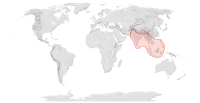Talk:Apis dorsata
| Insects Start‑class Low‑importance | ||||||||||
| ||||||||||
| Agriculture Start‑class Low‑importance | ||||||||||
| ||||||||||
![]() This article is or was the subject of a Wiki Education Foundation-supported course assignment. Further details are available on the course page. Student editor(s): Rasikareddy1019 (article contribs).
This article is or was the subject of a Wiki Education Foundation-supported course assignment. Further details are available on the course page. Student editor(s): Rasikareddy1019 (article contribs).
Peer Review
I think this had a lot of information in it and seemed to cover a lot of different types of material. I would possibly move the Nests section to be under Distribution and Habitat since nests can be thought of as a habitat. Also description of what the bee looks like, especially any differences between the drones and the queens. The entire first section needs some kind of citation since it just seems to be floating there with no way to find out where the information came from. Also, I would edit a couple of the names in the Taxonomy and Phylogeny section to be italicized since these are species names. Overall, I thought it was well done article. Tefrancis (talk) 01:30, 2 October 2015 (UTC)
Suggestions
This page seems incredibly well-researched and thorough, so great job! The main changes I made were some edits for grammar throughout the page. I did notice that in a few places, there were sentences that had no citations (particularly in the beginning of the "Nests" section, "Distribution and Habitat," and "Genetic Relatedness"). Additionally, I think the "Colony Cycle" section can be edited a bit for clarity. The paragraph begins with a sentence outlining the two major methods of reproductive swarming, then abruptly switches to talking about non-reproductive methods of colony initiation. I think a better transition could be used here, or perhaps this can be made into sub-heading. Finally (and perhaps this is stylistic or nit-picky), I feel like the sentence in the overview paragraph beginning, "The subspecies with the largest individuals..." is a bit cumbersome and specific for an overview. Perhaps it can be changed to something along the lines of "Several subspecies of A. dorsata have been identified with an average worker length of 17-20 mm; the largest of these subspecies is the Himalayan cliff honey bee, A. d. laboriosa." Otherwise, I think this is really well done! (Mpmaz (talk) 20:28, 1 October 2015 (UTC))
Add map
Add

to the article — Preceding unsigned comment added by 91.182.100.6 (talk) 09:32, 5 June 2012 (UTC)
Suggestions
You clearly did a ton of research and I think this article is going to end up being a really good one! The use of links to other wiki pages is great, and will help give context to the comparisons you make between A. dorsata and closely related species. There are a few times where you make reference to "differences" between particular behaviors, such as in the Nests sections when you start by saying they differ significantly from other bees. I think that if you say something like this, you have to explain the differences more by saying something like "while most bees do _____, A. dorsata does______", or else mentioning a difference doesn't provide any information. I'm not sure if this applies to your bee species, but chemical communication plays a central role in most of the nest dynamics in the one I am researching. If chemicals are also important for A. dorsata, I would suggest focusing future research on this and it would add great information to many of the behavior sections. Lastly, I did some small text edits to help with clarity or to cut out redundancy. You should go back and edit the Worker Policing section, as I couldn't understand most of the information you presented there. Definitely a good first draft, and the volume of information you present is huge. Good luck the rest of the way! Melliott132 (talk) 02:44, 2 October 2015 (UTC)


